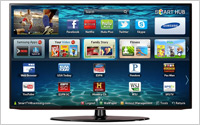
Nearly half of home entertainment devices in the U.S. are connected and being used for their online capabilities, but the level of use varies
widely by device.
Streaming media players and video game consoles are connected and used the most, while connected TVs and Blu-ray disc players are the least likely to be tied to the Web and
used for their online features, according to a new NPD Group study.
Only 30% of connected TVs and 32% of Blu-ray players in U.S. homes are actually connected and used for online access.
By next year, NPD projects that streaming media players such as Apple TV and Roku will surpass the number of Blu-ray players installed and connected to the Internet, although it has not yet
released figures in relation to that prediction. The overall number of Blu-ray players will still be higher than those of streaming devices in households.
advertisement
advertisement
Streaming media devices are gaining
ground in the over-the-top content market because their products are geared more to online content delivery, noted John Buffone, director of NPD’s Connected Intelligence service. While many
Blu-ray players now come equipped with apps like Netflix, “it’s a relatively stagnant array of apps that you can access…where if you have a Roku device, it’s constantly being
updated with new content,” he said.
That said, Blu-ray manufacturers are trying to get more Web-savvy. Samsung this week announced it will soon start shipping players powered by Opera,
best known for its Web browsing software. The Opera Devices SDK (Software Development Kit) will provide video support for YouTube, BBC iPlayer and other streaming services.
At the same time,
Roku, Apple TV and Boxee could soon be getting additional competition from Amazon, which is
reportedly getting ready to launch a new TV set-top box later this year to stream video into users’ living rooms. The e-commerce giant already operates a video on-demand service, free to
Amazon Prime members.
One company that stands to benefit from the rise in video streaming via TV is Netflix. NPD found that 40% of TVs connected to the Web, either through the TV itself or
another device, are already watching Netflix. YouTube is a distant second, with 17% streaming the Google-owned video service, followed by Hulu Plus, at 11%.
“Content usage remains
dominated by Netflix and YouTube,” said Buffone. He pointed out that Netflix from early on focused on offering access across any home entertainment device rather than selling its own dedicated
player. The company earlier this week reported having nearly 28 million paid U.S. streaming subscribers at the end of March, putting it roughly on par with HBO.
The findings in NPD’s
“Connected Home” report -- which does not include data on tablets or smartphones -- were based on a survey of more than 4,000 U.S. adults in the first quarter.